Abstract
The Grand Canal was an important transportation facility in ancient China, and the ancient towns along the canal were once very prosperous commercial centers. With the development of industrialization and urbanization, the ancient towns along the canal gradually declined. This paper took the canal and ancient towns in northern Zhejiang as the research object to reveal the concurrent relationship between canal changes and the rise and fall of ancient towns. This study summarized the development revelations of ancient canal towns and put forward the current development strategy of cultural tourism in ancient towns. Effective government policies protect the cultural heritage of the ancient town. Reasonable industry layout promotes the development of the cultural tourism industry in the ancient town. Public participation is needed to build a harmonious living community.
1. Introduction
Canals are a great invention of mankind and an important infrastructure for economic development, and there is a long history of canal development all over the world. Ancient Egyptians dug canals more than 4000 years ago [1]. The canal diverted water from the Nile [2] and irrigated large areas of land on both sides of the river [3]. During the same period, many canals were dug and dams were built in the Two Rivers Valley [4]. The Sumerians were good at dredging and managing rivers [5]. These facilities promoted local agriculture [6]. Canals have been important agricultural facilities and important transportation routes for thousands of years [7]. In addition, canals play an important role in economic development. For example, with the opening of the Suez Canal, European ships to West Asia no longer had to detour around the Cape of Good Hope in Africa, allowing cities in the Mediterranean to flourish once again. The opening of the Panama Canal changed global shipping traffic and the fortunes of many cities.
China’s Grand Canal, a World Heritage Site, was constructed 2500 years ago [8]. The Grand Canal is also the longest man-made canal in the world, running 1790 km from Beijing to Hangzhou [9]. The Grand Canal connects five major water systems in China (Figure 1) and has a significant impact on the ecology and economic development of both the northern and southern regions of China. The southernmost part of the Beijing–Hangzhou Grand Canal is known as the Jiangnan Canal, which flows through the Hangjiahu Plain and connects the major cities of Shanghai, Hangzhou, and Suzhou. Since ancient times, Jiangnan has been famous for its prosperity and affluence, known as “the land of fish and rice” and “the capital of silk”. The Jiangnan Canal is 323.8 km long, generally navigable for ships of 40 to 100 tons, with an annual cargo volume of more than 16 million tons. It is the busiest waterway for the transportation of the Beijing–Hangzhou Canal. Ancient towns on both sides of the canal, such as Wuzhen and Xitang, have become an important part of the canal culture with their unique architectural style, rich historical relics, and deep cultural heritage. The development of the Jiangnan Canal witnessed the economic prosperity and cultural exchanges of the whole Jiangnan region.
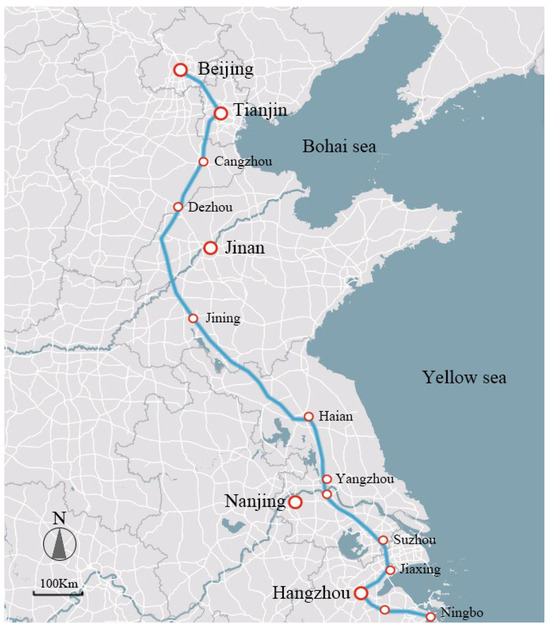
Figure 1.
The Grand Canal from Beijing to Hangzhou.
2. Literature Review
Currently, the research fields of the Grand Canal include heritage conservation and spatial morphology. Yan Huang et al. studied the distribution of cultural heritage in the Suzhou section of the Grand Canal [10]. Jiayu Wang et al. examined the challenges facing the conservation of the water heritage of the Beijing section of the canal [11]. Mo Chen et al. focused on the distribution and tourism characteristics of inCanalible cultural heritage on both sides of the canal [12]. A large number of studies have focused on canal tourism, from visitor perceptions [13] to the tourism loyalty of the Beijing Canal Forest Park [14]. A study shows that travelers’ choices are linked to the environment and risk. The green development of Hangzhou Canal Park also attracted attention [15]. The research on the evaluation of the Grand Canal Scenic Area [16] and tourists’ perceptions [17] were current research hotspots. There are also studies focused on the development of ancient canal towns. Yan Zhao et al. studied the spatial and temporal evolution of residential houses on both sides of the canal [18]. Weilu Lv et al. investigated the analysis of the topology of ancient canal towns [19]. Other scholars have proposed macro-historical changes in the Grand Canal and important cities [20]. Some scholars pay attention to the tourism industry of the ancient canal town [21]. Canal tourism can boost local economies. Zhang F. believes that canals are a good resource for recreational tourism [22], and B. Prideaux’s study of canal tourism in Europe confirms this [23]. Except for famous scenic spots such as Wuzhen and Xitang [24], the cultural and tourism development of other ancient canal towns was not smooth. A large amount of online review data showed that tourists were very averse to the phenomenon of homogenization in ancient towns [25,26,27]. How could this problem be solved? Scholars proposed the study of the local characteristics of ancient towns [25], hoping to achieve tourism development in ancient towns through differentiation [26]. Scholars also explored the needs of tourists using tourist review data. The methods of data mining included semantic analysis, machine learning [27], and deep learning techniques [28]. These modern technological techniques were very effective [29], but they overlooked the excavation of historical and cultural backgrounds. Different ancient towns took different development paths, such as the Han costume festival in Xitang [30] and the drama festival in Wuzhen [31], which were successful cases based on their own resources. However, there has been almost no research on the mechanisms behind the changes in the Jiangnan Canal’s waterways and the rise and fall of ancient towns. From a macro-historical perspective, this paper examines the significant historical milestones in the transformation of the Jiangnan Canal and investigates its role in economic development.
3. Methodology
Based on a review of the historical literature, this study mapped the changes of the canal and summarized the rise and fall of ancient towns along it. The researchers investigated the current industries in these ancient towns and revealed the characteristics and modes of their development. This study provided valuable experiences and lessons for the development, utilization, and protection of the canal’s river resources and offered references and insights for the sustainable development of today’s cities and regions.
3.1. Changes in the Jiangnan Canal
There are numerous river systems in the south of the Yangtze River [32], making long-distance travel by boat more convenient than on foot. The original function of the canal was to transport armies and strategic materials, which was of great strategic significance during times of war. In times of peace, the canal served as the economic lifeline of the empire, acting as an ancient national highway with significant transportation value.
3.1.1. The Hundred-Foot Canal and the Yue Shui Canal: The Early Formation of the Jiangnan Canal
The construction of the Jiangnan Canal can be traced back to the Spring and Autumn Periods (BC770–BC476) [33]. This historical event profoundly influenced the economic and military development of the Wu and Yue states, as well as the cultural landscape of the entire Jiangnan region. Utilizing the densely networked water system of the Hangjiahu Plain, the Wu and Yue states excavated artificial waterways from Lake Taihu to the QianCanal River. According to “Yue Jue Shu”, the main function of the canal was to transport food for war [34]. The canal connected the states of Wu and Yue, improving the local farming and irrigation conditions and promoting the prosperous development of agricultural production. In 482 BC, to consolidate his rule and develop his economy, King Goujian of Yue further excavated the Yue Shui Canal (Figure 2). The Yue Shui Canal is 7.5 km long, linking Chongfu and Chang An towns. The canal was initially driven by military necessity under the administrative will of the state, but it also gave rise to the early prototype of the ancient canal towns.
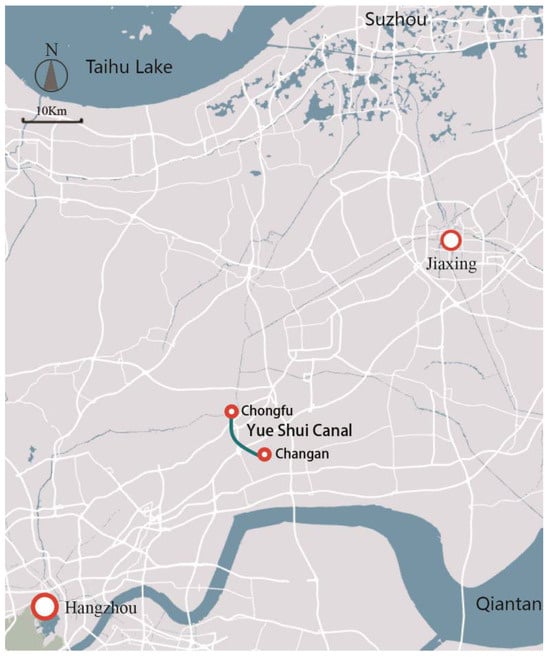
Figure 2.
Yue Shui Canal.
3.1.2. Lingshui Canal: A New Canal Chapter in the Southeast
After the unification of the six states by the Qin Dynasty (BC221–BC207), to strengthen centralized rule, many canals were dug in the southeastern region, including the Lingshui Road, which runs from the town of Chang’an to Hangzhou. According to “Yue Jie Shu”, Qin Shihuang built the Lingshui Road, which connected the water system of Zhejiang and formed a more complete water transportation network. Historians have found that the present-day river overlaps with the Qin Dynasty Lingshui Canal in some areas, which provides an important physical basis for identifying the specific site of the Lingshui Canal (Figure 3). The excavation of the Lingshui Road not only had military strategic significance but also promoted economic and cultural exchanges between Hangzhou and Jiaxing.
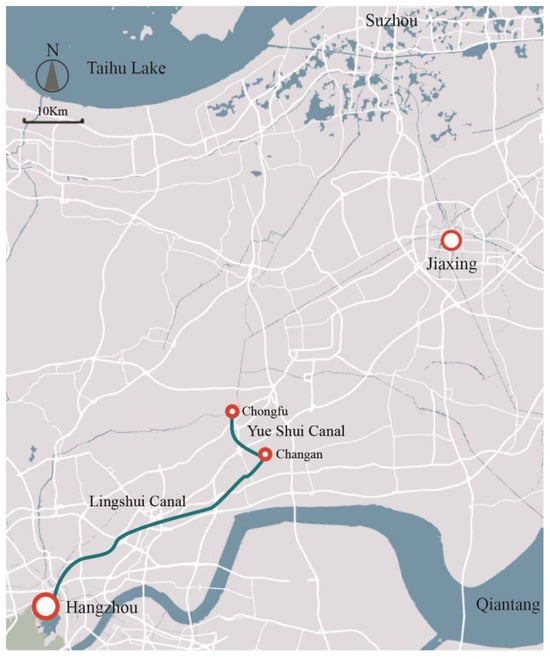
Figure 3.
Lingshui Canal.
3.1.3. Suzhou Canal and Hangzhou Canal (Northern Section): The Rise of the Jiangnan Canal
During the Western Han Dynasty, Emperor Wu of the Han Dynasty (BC156–BC87) ordered the excavation of the Suzhou Canal, which runs for hundreds of miles between Suzhou and Jiaxing, to strengthen his imperial rule (Figure 4). The opening of the Suzhou Canal not only promoted the economic and cultural exchanges between Suzhou and Jiaxing but also made the town of Wangjiangjing an important gateway from Suzhou to Jiaxing, which was known as the “Gateway to Northern Zhejiang”. During the Sui Dynasty (AD581–AD618), Emperor Yang further promoted the excavation and widening of canals to strengthen north-south transportation. He ordered the dredging and widening of the existing ancient canals, creating the wider Jiangnan Canal. The section of the canal from downtown Jiaxing through Shimen to Chongfu was called Hangzhou Canal (Figure 5), which became an important part of the Jiangnan Canal. The opening and widening of the Hangzhou Canal enhanced the navigability of the Jiangnan Canal.
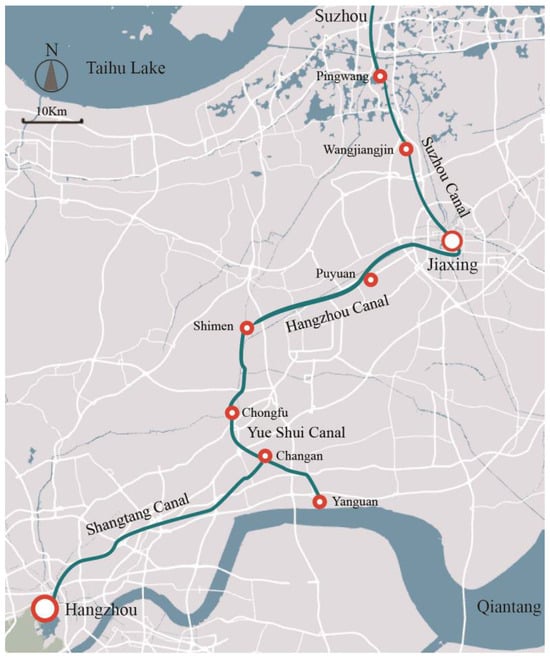
Figure 4.
Suzhou Canal.

Figure 5.
Hangzhou Canal.
3.1.4. Jiaxing Ring River and Hangzhou Canal (Southern Section): Development of the Canal System and the Rise of Ancient Towns
During the Canal and Song dynasties (AD960–AD1279), the rapid commercial development of Jiangnan Canal transportation capacity gradually became a key factor restricting the development of the region. To the end of the Yuan Dynasty (AD1271–AD1368), due to the narrow channel of the Shang Canal River hindering the transportation of military supplies, Zhang Shicheng, who ruled Jiangsu and Zhejiang, forced the military to excavate the Hangzhou Canal (southern section) from Chongfu to Hangzhou. The implementation of this project not only widened the channel of the canal to improve the efficiency of transportation but also, with the opening of the Hangzhou Canal in the Sui Dynasty (northern section), connected to the formation of a complete Hangzhou Canal from Jiaxing to Hangzhou (Figure 6). The five main bodies of the Jiangnan Canal-Suzhou Canal, Jiaxing Ring River, Hangzhou Canal, Chongchang Canal, and Shang Canal River (Figure 7) constitute a large and complex canal system.
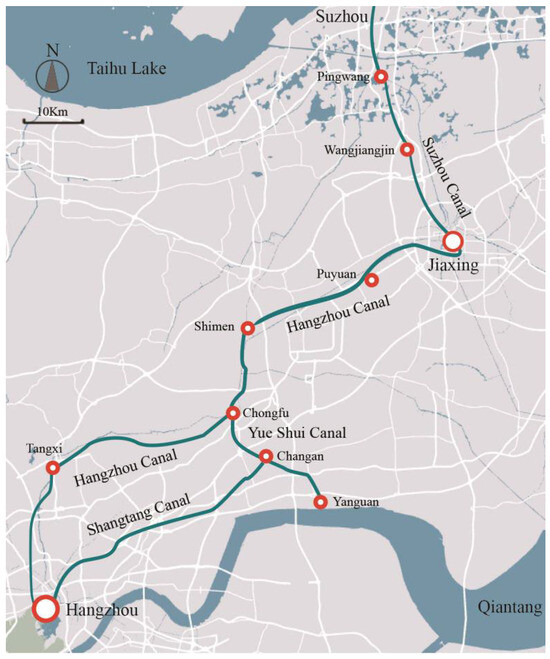
Figure 6.
Hangzhou Canal (southern section).
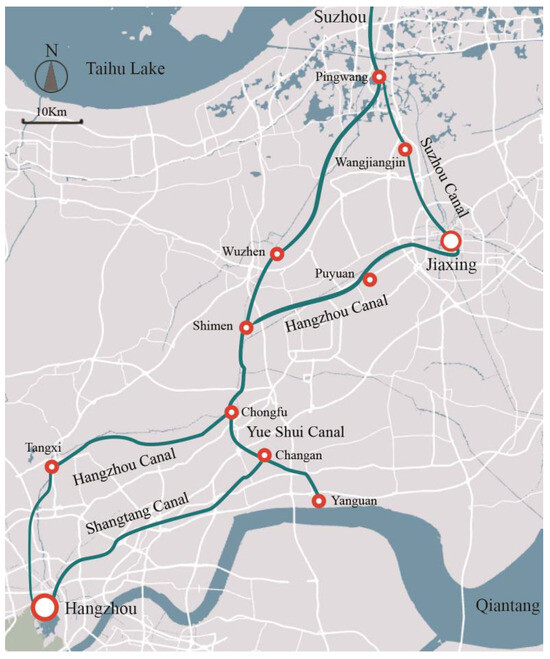
Figure 7.
Northern Zhejiang Canal.
3.2. Economic Activity in the Ancient Town
There is a strong correlation between the development of the ancient town and the change of the canal’s course, and its development stage can be divided into four phases, with the development of the ancient town positioned differently in each phase.
3.2.1. Spring and Autumn—Qin and Han: Strategic Needs
During the Spring and Autumn Period (BC770–BC476), the Hangjiahu area was an ancient battlefield between the Wu and Yue states [35]. Early canals were built only for strategic reasons and did not form important trade routes, nor were the routes large. During the Qin (BC221–BC207) and Han Dynasties (BC202–AD220), commercial trade was low, and ancient towns were strongholds for strategic needs. For example, the towns of Chang’an and Chongfu were military strongholds in the early days, and Yanguan was an important salt tanning site for the empire. According to historical speculation, the ancient canal towns of a certain size before the Sui Dynasty included Pingwang, Wu Xing, Chongfu, Chang’an, and Yanguan.
3.2.2. Sui, Tang, and Song: Transportation Demand
During the Tang (AD618–AD907) and Song dynasties (AD960–AD1279), the central plains experienced three wars: the Yongjia Rebellion [36], the Anshi Rebellion, and the Jingkang Rebellion [37]. The population moved southward in large numbers, and many big families from the north settled along the banks of the canal, gradually forming ancient towns such as Wangjiangjing, Puyuan, and Chongfu. Rapid population growth and a significant increase in agricultural development in the southern part of the country. The Book of Song records that the land in Jiangnan is fertile and rich in food production [38]. In addition to the developed agricultural production, the well-connected water transportation gave rise to the development of commerce and trade and the frequent exchanges of economy and culture between the north and the south. Ancient towns in the transportation node of the canal have both strategic and economic value, of which Chang’an Town is a typical representative. Due to the water level difference between Chongchang Harbor and Shangtang River, water conservancy projects have been established in Chang’an Town since the Canal Dynasty to regulate the water level. In the Song Dynasty, the three gates and two Aos were formed, which have been famous for generations [39]. The establishment of the three gates of Chang’an made the town the most prosperous ancient town within Jiaxing at that time, and the descriptions of many Song Dynasty poets reflected the prosperity of the time.
3.2.3. Yuan, Ming, and Qing Dynasties: Demand for Trade and Commerce
As times changed, so did the canal’s shipping routes. In the Yuan Dynasty, Zhang Shicheng ordered the new opening of Hangzhou Tang (southern section), and the merchant ships from Jiaxing to Hangzhou directly took the route from Chongfu Town to Canalqi Town to enter Hangzhou, which directly contributed to the prosperity of Canalqi Ancient Town. During the Ming (AD1368–AD1644) and Qing Dynasties (AD1644–AD1911), the economy of Jiangnan presented a more prosperous scene [40]. As an important trade node of the Beijing–Hangzhou Grand Canal, the ancient town of Canal not only became a hub for the transportation of materials from north to south in transit but also a bazaar for the neighboring villages to trade agricultural products, making the economy of the ancient town even more prosperous. Meanwhile, the ancient town has also become an important place for cultural exchange. Literati and writers have gathered here for literary and artistic creations and exchanges, making the ancient town of Canal also present a prosperous cultural scene. During the Ming and Qing dynasties, new waterways also appeared from Pingwang Town in Jiangsu Province to Canalqi, via Wuzhen, Lianshi, and Xinshi, which were also part of the Jiangnan Canal [9]. Although different from the Beijing–Hangzhou Grand Canal, which was used by the Qing emperors on their “southern tours”, this canal was a shortcut to Hangzhou and greatly improved transportation efficiency. The use of this shortcut allowed the famous town of Wuzhen to become rapidly wealthy.
3.2.4. Contemporary Renaissance: Development of the Cultural and Tourism Industry
The commercial prosperity along the Jiangnan Canal continued until the late Qing Dynasty [41]. As shipping matured and the maintenance costs of inland waterways rose, shipping gradually replaced canal transport. In modern times, the rise of railroads, highways, and other new transportation methods caused canal shipping to lose its former advantages, leading to a decline in commercial activities in ancient towns. The siltation and disrepair of the canals further aggravated this decline, stunting economic development and prompting some residents to relocate in search of better opportunities. In recent years, tourism and a renewed emphasis on history and culture have drawn government attention to the protection and revitalization of ancient canal towns. Joint efforts by the government and private sector have brought new life to well-known towns like Wuzhen and Xitang [42], attracting many tourists. Organizing cultural activities, festivals, and celebrations has enhanced the cultural appeal of these towns, promoting local traditions. These initiatives have revitalized the economies of the ancient towns, revived original commercial districts, and improved local residents’ living standards. Research on ten typical ancient canal towns, as listed in Table 1, shows that these towns are actively seeking their own development paths and striving for revitalization. Having gone through cycles of origin, prosperity, decline, and revival, the ancient canal towns are now experiencing renewed vitality and vigor.

Table 1.
Overview of the research on ten typical ancient canal towns.
4. Results
Based on the historical textual research of canal channel changes and the investigation of ancient town commerce, this paper reveals the mechanism of the rise and fall of ancient towns. The rise and fall of ancient canal towns have provided us with rich historical experience and profound insights. The evolution of these ancient towns is not only closely related to the natural environment and economic development but also influenced by various factors such as top-level government design, public participation, and industrial integration.
4.1. National Top-Level Design
The rise of ancient canals directly benefited from the ruler’s macro-planning and strategic layout, and this top-level design laid a solid foundation for the prosperity of ancient towns. Similarly, the current development of ancient canal towns also needs effective planning and policy guidance at the national level, including scientific and reasonable planning and design, targeted policy incentives, perfect infrastructure construction, etc. Through top-level design, it can make clear the development direction and goals of the ancient towns, optimize the allocation of resources, and enhance the comprehensive competitiveness of the ancient towns. At the same time, the top-level design can also ensure that the ancient town can realize sustainable development and long-term prosperity on the basis of protecting traditional culture.
4.2. Active Public Participation
Public participation has also played an important role in the development of ancient towns. Whether it is the construction of water conservancy, ancient town construction, or trade activities, the support and participation of local residents and stakeholders needs to be obtained. Public participation not only provides a constant impetus for the development of the ancient town but also ensures that decisions and actions can be close to public opinion and in line with the needs of the people. Therefore, the current development of ancient canal towns also needs to focus on public participation, promote democratic decision-making, and promote community self-government to ensure that the protection and inheritance of ancient towns are closer to the public, reflecting public opinion.
4.3. Industrial Integration and Development
The rise and fall of ancient canal towns are also closely related to industrial integration. Ancient trade, handicrafts, cultural heritage, and other industries in the development of ancient towns integrated with each other to form a unique economic ecosystem, laying a solid foundation for the prosperity of the ancient town. This deep integration between industries not only promotes the optimal allocation of resources but also promotes the diversified development of the ancient town economy. The current development also needs to focus on industrial integration; by promoting interpenetration and collaboration between different industries, it can further bring into play the characteristic resource endowment of the ancient town and enhance its core competitiveness. Canal towns should advocate differentiated competition, relying on their unique culture, history, natural resources, and other advantages, as well as the development of local industry characteristics.
4.4. Linear Heritage Space
Canal has a typical linear cultural heritage, and this linear feature makes the development of ancient canal towns not confined to the individual itself but should be considered from the perspective of the whole canal circle. As a linear golden waterway, the canal has a rich history of commerce, culture, and exchange activities. It connects ancient towns in different regions and promotes economic, cultural, and social exchanges and integration in various places. This cross-regional connection has brought rich resources and opportunities to the ancient towns of the canal and provided a broad space for its development. This reveals that we should fully recognize the importance of linear heritage space. The prosperity and development of the ancient canal towns can be further promoted by strengthening the exchanges and connections between regions and promoting the exchange and integration of multiple cultures. At the same time, we should also pay attention to protecting the integrity and continuity of the canal as a linear cultural heritage to ensure the inheritance and continuation of its historical and cultural values.
4.5. Internet Celebrity Thinking
The historical changes in the ancient town of Canal fully demonstrate the important role of flow in promoting regional economic development. The ancient canal town flourished because of its proximity to the water, which not only brought rich natural resources but also promoted the convergence of people, goods, and capital flows, making the ancient town an important center of commerce and trade prosperity. This traffic-driven development model has brought economic prosperity and cultural prosperity to the ancient town. In today’s information and networked era, traffic thinking also has important application value. For the ancient canal town, how to attract people, goods, and capital flow is the key to promoting its economic development. The use of traffic thinking can not only bring short-term economic benefits for the canal town but also promote its long-term development.
5. Discussion
This paper discussed the development strategy of culture and tourism in ancient canal towns from three dimensions: government policy, industrial integration, and public participation.
5.1. Government Policy Support
The Grand Canal, as a mega-project driven by national top-level design and administrative will, is undoubtedly the external driving force for the rise of ancient canal towns. In the process of protection, inheritance, and utilization of ancient canal towns, the government plays the role of initiator, leading core, and final decision-maker. Therefore, it is the key to the revitalization of ancient canal towns to actively play the top-level design ability of the government.
At the macro-development strategy level, the government should be far-sighted, from the overall spatial layout, to create a regional canal culture and tourism circle (Figure 8) to share the region’s high-quality tourism resources. In the mesoscopic layout of the industry, the government, through policy guidance, plans the layout of the canal culture industry in Jiaxing and the establishment of special funds for culture, the establishment of a key project library, improving the talent system, stimulating the vitality of the market, and boosting the development of the canal culture industry in Jiaxing. In microcultural space creation, the government should encourage public innovation, especially canal IP innovation, and give full play to folk wisdom in net space creation to realize the diversification and specialization of cultural space.
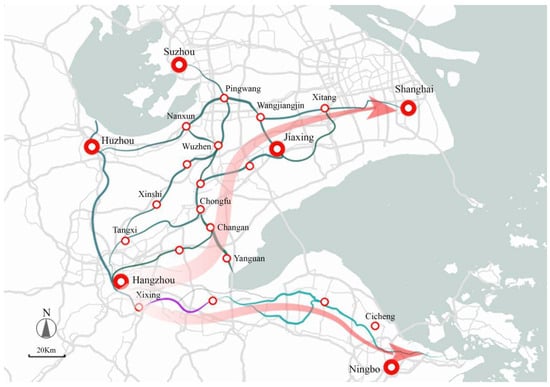
Figure 8.
Northern Zhejiang canal area tourism map.
In the 2023 World Canal Ancient Towns Cooperation Mechanism Meeting, Jiaxing put forward the brand positioning of “China’s ancient towns to see Jiaxing” (Table 2). This development positioning not only highlights the unique charm of Jiaxing’s ancient canal towns but also reflects the government’s important top-level design for the living heritage of ancient towns. As shown in Table 2, the government actively devotes itself to excavating the qualities of the ancient town and strengthens the research and planning of the living heritage of the ancient town to determine its development positioning [43]. Aiming at different market demands and combining with the resource endowment of ancient towns, it plans various themed tour routes. Guiding the private capital and public power to protect, inherit, and utilize the valuable heritage, realizing the sustainable development of the ancient canal town.

Table 2.
Canal town tour route themes.
5.2. Integration of Cultural and Tourism Industries
With the increasing improvement of material civilization, people’s needs began to shift to spiritual civilization. In recent years, people have paid more attention to the improvement of the quality of life, and the tourism economy has become an important force to promote social progress. Cultural tourism projects around the world continue to burst out of the circle, becoming a hot topic of discussion on the network. Museums Popular has become the focus of network discussion. Canal towns are a witness to history and cultural carriers; their historical changes provide us with valuable insights: the development of commercial trade is the endogenous driving force of the prosperity of the canal towns, while the integration of culture and the tourism industry is the main path for the revitalization of the current towns. Traditional villages and towns are important carriers of history and culture, as well as living spaces inhabited by a large number of people and popular scenic spots for cultural tourism. According to statistics, traditional villages and towns in Zhejiang Province have a large number of tourists; only Wuzhen, Nanxun, and Xitang towns have more than 35 million tourists per year [38]. The ancient town cultural tourism popularity study based on the number of online reviews on evaluation websites is shown in Figure 9.
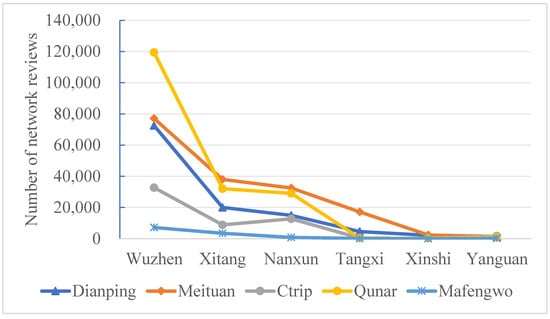
Figure 9.
Six ancient canal towns of concern.
However, through the research, it was found that the current demand for cultural tourism presents a diversified trend, and there is a significant difference in the tourism demand of tourists of different age groups and different cultural backgrounds. For example, young people pursue net red punch card tours in pursuit of fresh and exciting travel experiences; middle-aged people tend to prefer parent-child cultural and expo tours, focusing on cultural inculcation and family interaction; while the elderly favor health and leisure tours, pursuing tranquility and comfort. Research shows that mainstream tourists are not interested in cultural tourism programs with vague characteristics and poor spatial content [44]. So, the traditional ancient town tour program has actually been unable to meet the new demand. Therefore, the innovation of the cultural tourism industry has become an urgent task. Under the new consumption pattern, meta-universe cultural tourism, immersive experiences, sports tourism, medical and health care, and other emerging forms of business are emerging, providing a broad space for the development of the ancient canal town. Among them, immersive experiences are especially attention-grabbing. Foreign studies have found that immersive experiences can enhance people’s expression of emotion and intention and make tourists more actively participate in tourism projects [45]. The latest market research has found that combining history with cutting-edge technology through the use of new technologies such as AR, VR, and AI not only has the potential to preserve and manage heritage but also has the potential to enrich the experience of tourists and deepen their connection to history. The application of new technologies such as AR, VR, and AI has spawned new businesses, new scenarios, and new models, bringing strategic opportunities for social, economic, and sustainable development and will have a tremendous impact on the tourism industry [46]. The rise of the cultural boom and the outbreak of new cultural and tourism business forms have put forward new requirements for the spatial camping of traditional canal town scenic spots. Research on ancient town tourism based on the favorable rate of online reviews is shown in Figure 10.
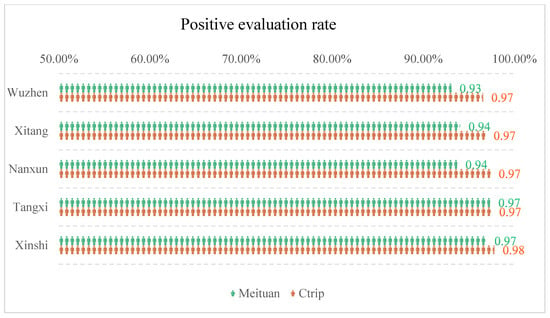
Figure 10.
Good reviews of the old town.
Therefore, the industrial integration of ancient towns should avoid the situation of “one size fits all”, and each ancient town should carry out in-depth research work to create clusters of ancient towns with different themes and characteristics based on excavating and refining their unique historical functions, cultural veins, and regional characteristics, and to realize the goal of a linear heritage theme tour of the canal with the help of the Canal Ring Road. For example, the four major ancient towns of Wuzhen, Chongfu, Xinshi, and Canalqi (Figure 11) are located at a distance of 20–30 km from each other.

Figure 11.
Canal-integrated tourism loop design.
According to the current design speed of water buses, it takes about 30–45 min to traverse to another ancient town, which can spatially realize resource sharing and synergistic development through the canal loop. Each of the four ancient towns has its own characteristics, and although they belong to Hangzhou, Jiaxing, and Huzhou, they are fully capable of forming a self-contained loop tourism area, sharing visitor traffic and tourism resources, and creating greater tourism value. Additionally, the scenic industry of ancient canal towns should be integrated with local commercial centers to foster positive interactions between tourism and commerce. This integration can enrich tourists’ experiences while also serving as leisure and entertainment hubs for local residents. While tourist numbers fluctuate seasonally, the consumption patterns of local residents remain relatively stable, providing strong support for the town’s sustainable development.
Furthermore, the cultural and creative products of ancient towns are crucial in reflecting regional characteristics and cultural heritage. It is important to avoid the generic presentation of “Yiwu small commodities” stores. Instead, cultural heritage should be respected, and local traditional culture and handicraft history should be fully explored to create cultural and creative products with regional IP characteristics (Table 3). This approach will not only enhance the cultural appeal of the ancient town but also provide a more profound travel experience for tourists.

Table 3.
New forms of business in old canal towns.
5.3. Active Public Participation
The people are the main force behind the construction and maintenance of the Grand Canal, and public participation is a force to be relied upon for the revitalization of the ancient canal towns. Traditional conservation models are often dominated by governments, developers, and experts, with residents often in a passive position. More and more studies show the importance of the public participation model, for example, the Xiamen Co-Creation Workshop model [47]. Through activities such as public opinion consultation meetings and public consultation meetings on the proposal, multiple parties, such as the government, planners, experts, and residents, can participate in the planning and decision-making and promote interactive exchanges among multiple subjects so as to realize the revival of the old town again. The implementation of this model not only helps to explore the essence of the cultural neighborhood but also presents its unique charm and gives the ancient town new vitality and vigor. In the field research of Jiaxing Canal Ancient Town, we found that we deeply felt that the local residents had a deep affection for the town.
Ancient towns serve as spiritual homes, carrying the life experiences and emotional memories of the indigenous people. When these towns and neighborhoods are developed without the participation of their original inhabitants, they lose vitality and vibrancy. Therefore, it is crucial to fully consider residents’ opinions and suggestions at the outset of planning and design. Research on Chongfu, a thousand-year-old town, revealed that a lack of commercial development led to deserted restored antique streets and the displacement of indigenous residents, resulting in a scarcity of tourists and a lack of vitality. In contrast, an old street just a hundred meters away, serving as the local commercial center, remains full of commercial activity. Indigenous people are also important consumers in ancient towns.
Public participation is essential to better exploring the essence of cultural neighborhoods and presenting their unique charm. Additionally, involving the community enhances residents’ sense of identity and belonging, encouraging them to actively participate in the protection and development of their neighborhoods. Commercial activities play a significant role in the development of ancient towns, with people at their core. An ancient town brimming with activity and popularity is vibrant and appealing. Thus, in developing cultural tourism, it is important to emphasize local humanities and cultural heritage, preserving the original commercial spaces and living atmosphere. By retaining the local populace and integrating both residents and tourists into the space, we can create an ancient town full of vitality and charm.
6. Conclusions and Discussion
The ancient town was gradually formed with the development of canal commerce. As the best carrier of the history and cultural inheritance of Jiangnan, the ancient town inherits a rich cultural heritage. The thousand-year-old canal town carries history and is more oriented toward the future. How to protect, inherit, and utilize this important cultural heritage is currently facing a major challenge. In this paper, we first retrospectively sort out the thousands of years of historical changes of Jiaxing Canal and then explore the mechanism of the rise and fall of the millennium canal town. Through the in-depth deconstruction of the historical lineage of ancient canal towns, we have gained five important insights: the leading role of top-level design, the indispensability of public participation, the inevitable trend of industrial integration, the unique value of linear heritage, and the modern use of flow thinking.
Based on this, we propose targeted living heritage strategies aimed at revitalizing the thousand-year-old canal towns and promoting the construction of the Grand Canal Cultural Belt and the Grand Canal National Cultural Park [48]. These strategies not only focus on the historical protection and cultural inheritance of the ancient towns but also on the future development and vitality injection of the ancient towns. On the other hand, summarizing the revelations of the rise and fall of ancient towns along the coast and revealing the characteristics and laws of town development can also help us learn from the lessons learned from the development, utilization, and protection of water resources in the ancient canals and provide references and revelations for today’s sustainable development of cities and regions.
This paper focuses on summarizing the principles of prosperity and decline of ancient towns in the historical changes of canals through social science research methods. This article is the beginning of a study on the development of cultural tourism in the ancient town of Canal. The article lacks certain data support, and the necessary quantitative analysis will be added in the follow-up research. Subsequent studies will utilize deep learning principles to study the construction of historical landscapes in ancient canal towns, analyze tourists’ views on ancient town tourism using online big data, and utilize building physics principles to analyze the thermal environmental comfort of ancient towns.
Author Contributions
W.J. designed and supervised this study. W.J. performed the experiments. W.J. analyzed the data analysis. W.J. prepared the manuscript. W.J. and H.F. revised the manuscript. All authors read and approved its content. All authors have read and agreed to the published version of the manuscript.
Funding
This research was supported by the Philosophy and social science planning projects in Hangzhou (M24YD085).
Institutional Review Board Statement
Not applicable.
Informed Consent Statement
Not applicable.
Data Availability Statement
The data presented in this study are available on request from the corresponding author.
Conflicts of Interest
The authors declare no conflict of interest.
References
- Sneh, A.; Weissbrod, T.; Perath, I. Evidence for an Ancient Egyptian Frontier Canal: The Remnants of an Artificial Waterway Discovered in the Northeastern Nile Delta May Have Formed Part of the Barrier Called “Shur of Egypt” in Ancient Texts. Am. Sci. 1975, 63, 542–548. [Google Scholar]
- Mays, L.W. A Very Brief History of Hydraulic Technology during Antiquity. Environ. Fluid Mech. 2008, 8, 471–484. [Google Scholar] [CrossRef]
- Tuan, Y.-F. Early Hydraulic Civilization in Egypt: A Study in Cultural Ecology; Taylor & Francis, Ltd.: New York, NY, USA, 1977. [Google Scholar]
- Altaweel, M. Southern Mesopotamia: Water and the Rise of Urbanism. WIREs Water 2019, 6, e1362. [Google Scholar] [CrossRef]
- Adamo, N.; Al-Ansari, N. The Sumerians and the Akkadians: The Forerunners of the First Civilization (2900–2003BC). J. Earth Sci. Geotech. Eng. 2020, 10, 17–39. [Google Scholar]
- Schrakamp, I. Irrigation in 3rd Millennium Southern Mesopotamia: Cuneiform Evidence from the Early Dynastic IIIb City-State of Lagash (2475–2315 BC); Edition Topoi: Berlin, Germany, 2018. [Google Scholar]
- Hein, C.; Luning, S.; Meyer, H.; Ramos, S.J.; Van de Laar, P. Shipping Canals in Transition. Urban Plan. 2023, 8, 259–262. [Google Scholar] [CrossRef]
- Hucker, C.O. China’s Imperial Past: An Introduction to Chinese History and Culture; Stanford University Press: Redwood City, CA, USA, 1975. [Google Scholar]
- Cai, J.; Peng, J. Introduction of the Beijing–Hangzhou Grand Canal and Analysis of Its Heritage Values. In Water Projects and Technologies in Asia; CRC Press: Boca Raton, FL, USA, 2023; pp. 75–86. [Google Scholar]
- Huang, Y.; Yang, S. Spatio-Temporal Evolution and Distribution of Cultural Heritage Sites along the Suzhou Canal of China. Herit. Sci. 2023, 11, 188. [Google Scholar] [CrossRef]
- Wang, J.; Wang, M.; Dou, H.; Su, M.; Dong, H.; Liu, Z. Research on Climate Change and Water Heritage Tourism Based on the Adaptation Theory—A Case Study of the Grand Canal (Beijing Section). Sustainability 2023, 15, 7630. [Google Scholar] [CrossRef]
- Zhang, Y.; Jing, Z.; Huang, Q.; Wang, X.; Sun, W.; Zhang, C.; Wang, J.; Zhong, Y.; Wang, J.; Tan, L.; et al. On Conservation of World Heritage Beijing-Hangzhou Grand Canal for Enhancing Cultural Ecosystem Services. Herit. Sci. 2023, 11, 269. [Google Scholar] [CrossRef]
- Lu, L.; Jiao, M.; Weng, L. Influence of First-Time Visitors’ Perceptions of Destination Image on Perceived Value and Destination Loyalty: A Case Study of Grand Canal Forest Park, Beijing. Forests 2023, 14, 504. [Google Scholar] [CrossRef]
- Yao, X.; Sun, Y.; Sun, B.; Huang, Y. The Impact of the Urban Forest Park Recreation Environment and Perceived Satisfaction on Post-Tour Behavioral Intention—Using Tongzhou Grand Canal Forest Park as an Example. Forests 2024, 15, 330. [Google Scholar] [CrossRef]
- Xia, Y. Impact of Green Space on Residents’ Wellbeing: A Case Study of the Grand Canal (Hangzhou Section). Front. Public Health 2023, 11, 1146892. [Google Scholar] [CrossRef]
- Cai, Z.; Zhao, S.; Huang, M.; Zhang, C. Evolution Model, Mechanism, and Performance of Urban Park Green Areas in the Grand Canal of China. Land 2023, 13, 42. [Google Scholar] [CrossRef]
- Jiang, S.; Scott, N.; Tao, L.; Xiong, S.; Qin, Y. Perceived Destination Image Cohesion: A Comparison Study of Attractions on the Grand Canal, China. Sustainability 2023, 15, 13682. [Google Scholar] [CrossRef]
- Zhao, Y.; Bian, G.; Sun, T.; Yan, J. The In-Situ Spatial-Temporal Evolution of the Settlement Space along the Grand Canal Tianjin Section from the Perspective of Cultural Heritage. Land 2023, 12, 1023. [Google Scholar] [CrossRef]
- Lv, W.; Wang, N.; Huang, Y. Study on the Sustainability of Ancient Canal Towns on the Basis of the Topological Structure Analysis of Streets and Lanes: A Case Study of the Xixing Ancient Town. PLoS ONE 2023, 18, e0279979. [Google Scholar] [CrossRef] [PubMed]
- Huang, W.; Xi, M.; Lu, S.; Taghizadeh-Hesary, F. Rise and Fall of the Grand Canal in the Ancient Kaifeng City of China: Role of the Grand Canal and Water Supply in Urban and Regional Development. Water 2021, 13, 1932. [Google Scholar] [CrossRef]
- Wen, Y.; Li, S. Research on Protection and Utilization of Architectural Cultural Heritage in Canal Towns: A Case Study of Daokou Ancient Town. J. Landsc. Res. 2021, 13, 71–80. [Google Scholar]
- Zhang, F.; Yang, L.; Luo, X. A Study on the Distribution and Utilization of Recreational Resources Along the Grand Canal Culture Belt. Chin. J. Urb. Environ. Stud. 2019, 7, 1950015. [Google Scholar] [CrossRef]
- Prideaux, B. River and Canal Waterways as a Tourism Resource. In Advances in Hospitality and Leisure; Emerald Publishing Limited: Leeds, UK, 2023; pp. 137–153. [Google Scholar]
- Zhang, Q.; Lu, L.; Huang, J.; Zhang, X. Uneven Development and Tourism Gentrification in the Metropolitan Fringe: A Case Study of Wuzhen Xizha in Zhejiang Province, China. Cities 2022, 121, 103476. [Google Scholar] [CrossRef]
- Xu, Y.; Lu, L. Probing the Long-Term Evolution of Traditional Village Tourism Destinations from a Glocalisation Perspective: A Case Study of Wuzhen in Zhejiang Province, China. Habitat Int. 2024, 148, 103073. [Google Scholar] [CrossRef]
- Islam, M.N. Visitors’ Sentiment in Archeological Heritage Sites: A Study Based on TripAdvisor Reviews. Int. J. Hosp. Tour. Adm. 2023, 1–22. [Google Scholar] [CrossRef]
- Abang Abdurahman, A.Z.; Wan Yaacob, W.F.; Md Nasir, S.A.; Jaya, S.; Mokhtar, S. Using Machine Learning to Predict Visitors to Totally Protected Areas in Sarawak, Malaysia. Sustainability 2022, 14, 2735. [Google Scholar] [CrossRef]
- Guerrero-Rodriguez, R.; Álvarez-Carmona, M.Á.; Aranda, R.; López-Monroy, A.P. Studying Online Travel Reviews Related to Tourist Attractions Using NLP Methods: The Case of Guanajuato, Mexico. Curr. Issues Tour. 2023, 26, 289–304. [Google Scholar] [CrossRef]
- Han, Q.; Yin, C.; Deng, Y.; Liu, P. Towards Classification of Architectural Styles of Chinese Traditional Settlements Using Deep Learning: A Dataset, a New Framework, and Its Interpretability. Remote Sens. 2022, 14, 5250. [Google Scholar] [CrossRef]
- Zong, Y.; Tsaur, S.-H. Destination Experiences cape for Hanfu Tourism: An Exploratory Study. J. China Tour. Res. 2024, 20, 144–166. [Google Scholar] [CrossRef]
- Su, K. Research on Brand Communication Strategy of Wuzhen Drama Festival from the Perspective of IMC Theory. In Proceedings of the 2022 International Conference on Business and Policy Studies; Li, X., Yuan, C., Ganchev, I., Eds.; Applied Economics and Policy Studies; Springer Nature: Singapore, 2022; pp. 101–109. ISBN 978-981-19572-6-0. [Google Scholar]
- Yang, H.F.; Yang, S.L.; Xu, K.H.; Milliman, J.D.; Wang, H.; Yang, Z.; Chen, Z.; Zhang, C.Y. Human Impacts on Sediment in the Yangtze River: A Review and New Perspectives. Glob. Planet. Chang. 2018, 162, 8–17. [Google Scholar] [CrossRef]
- Jiange, W.; Qing, Z. Influence of Jiangnan Canal on Jiaxing and Huzhou Plain’s Polder System in Song and Yuan Dynasties. Landsc. Archit. 2019, 26, 21–27. [Google Scholar]
- Kang, Y. Yue Jue Shu; Art China: Shanghai, China, 1980. [Google Scholar]
- Chronological Narrative and Locale-Based Narrative in Early Chinese Prose: A Case Study of Wu-Yue Rivalry in Zuozhuan and Guoyu. Int. J. Comp. Lit. Transl. Stud. 2016, 4, 44–52. [CrossRef][Green Version]
- Choo, J.J.C. 1. Return To The North?: The Debate On Moving The Capital Back To Luoyang. In Early Medieval China; Swartz, W., Campany, R.F., Lu, Y., Choo, J., Eds.; Columbia University Press: New York, NY, USA, 2014; pp. 17–31. ISBN 978-0-231-15986-9. [Google Scholar]
- Liu, H. Apocalyptic Belief and Prophecy: Constructing Political Legitimacy during the Yuan-Ming Transition. J. R. Asiat. Soc. 2023, 33, 335–350. [Google Scholar] [CrossRef]
- Xuehai, C.; Klein, K. Research on Wei, Jin, and Northern and Southern Dynasties History from Taiwan and Hong Kong. Early Mediev. China 1998, 1998, 83–150. [Google Scholar] [CrossRef]
- Ebner Von Eschenbach, S.F. The Economy of Floods and Inundations in the Southern Song Capital Prefecture Lin’an (Hangzhou) on the Shore of the Zhe River Estuary and the Hangzhou Bay in Southeastern China During the Twelfth and Thirteenth Centuries. In Droughts, Floods, and Global Climatic Anomalies in the Indian Ocean World; Gooding, P., Ed.; Springer International Publishing: Cham, Switzerland, 2022; pp. 31–61. ISBN 978-3-030-98197-6. [Google Scholar]
- Faure, D. What Weber Did Not Know: Towns and Economic Development in Ming and Qing China. In Town and Country in China; Faure, D., Liu, T.T., Eds.; Palgrave Macmillan UK: London, UK, 2002; pp. 58–84. ISBN 978-1-349-66298-2. [Google Scholar]
- Wang, F.; Lin, B.; Liu, Q. Location, Urban Fabric and Transportation: Historical Morphogenetic Analysis of Tourism Cities along the Grand Canal. In Routledge Handbook of Tourism Cities; Routledge: New York, NY, USA, 2020; pp. 551–568. [Google Scholar]
- Zhang, S.; Liu, J.; Pei, T.; Chan, C.-S.; Wang, M.; Meng, B. Tourism Value Assessment of Linear Cultural Heritage: The Case of the Beijing–Hangzhou Grand Canal in China. Curr. Issues Tour. 2023, 26, 47–69. [Google Scholar] [CrossRef]
- Su, M.M.; Yu, J.; Qin, Y.; Wall, G.; Zhu, Y. Ancient Town Tourism and the Community Supported Entrance Fee Avoidance—Xitang Ancient Town of China. J. Tour. Cult. Chang. 2021, 19, 709–731. [Google Scholar] [CrossRef]
- Bec, A.; Moyle, B.; Timms, K.; Schaffer, V.; Skavronskaya, L.; Little, C. Management of Immersive Heritage Tourism Experiences: A Conceptual Model. Tour. Manag. 2019, 72, 117–120. [Google Scholar] [CrossRef]
- Robaina-Calderín, L.; Martín-Santana, J.D.; Muñoz-Leiva, F. Immersive Experiences as a Resource for Promoting Museum Tourism in the Z and Millennials Generations. J. Destin. Mark. Manag. 2023, 29, 100795. [Google Scholar] [CrossRef]
- Cranmer, E.E.; Dieck, M.C.T.; Jung, T. The Role of Augmented Reality for Sustainable Development: Evidence from Cultural Heritage Tourism. Tour. Manag. Perspect. 2023, 49, 101196. [Google Scholar] [CrossRef]
- Li, Y.; Zhang, S.; Zhu, D. Co-Creation of Community Micro-Renewals: Model Analysis and Case Studies in Shanghai, China. Habitat Int. 2023, 142, 102951. [Google Scholar] [CrossRef]
- An, Z.; Zhou, S. How to Construct National Identity Based on Cultural Heritages? A Case Study of the Grand Canal National Culture Park. Ecotourism 2023, 13, 408–419. [Google Scholar]
Disclaimer/Publisher’s Note: The statements, opinions and data contained in all publications are solely those of the individual author(s) and contributor(s) and not of MDPI and/or the editor(s). MDPI and/or the editor(s) disclaim responsibility for any injury to people or property resulting from any ideas, methods, instructions or products referred to in the content. |
© 2024 by the authors. Licensee MDPI, Basel, Switzerland. This article is an open access article distributed under the terms and conditions of the Creative Commons Attribution (CC BY) license (https://creativecommons.org/licenses/by/4.0/).